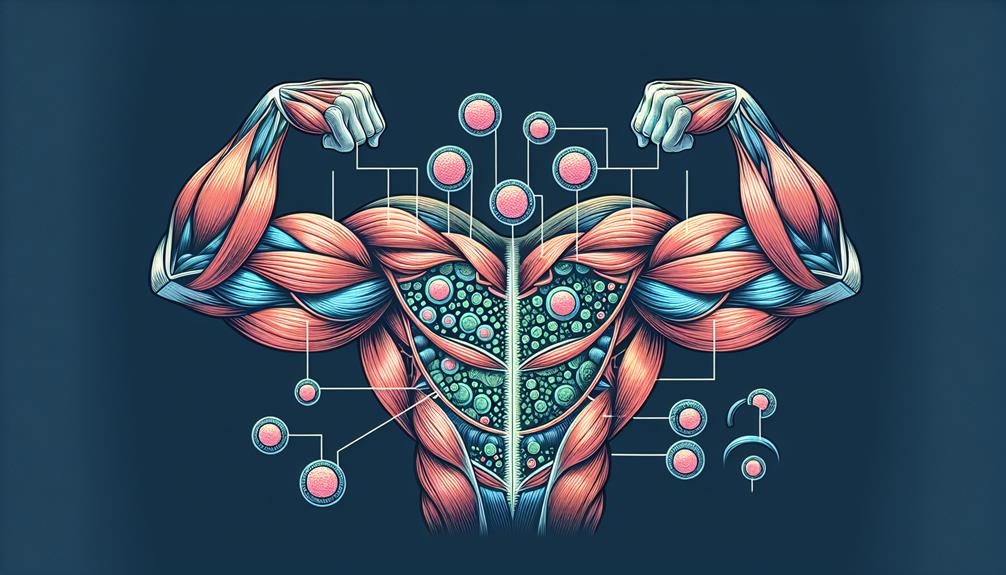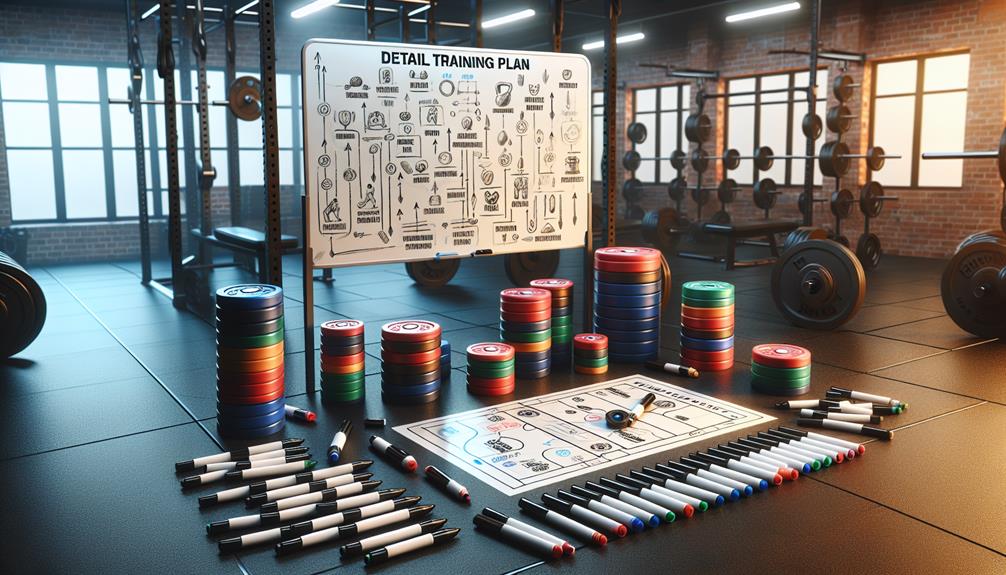They say that "knowledge is power," and when it comes to powerlifting, this adage holds true. If you're looking to gain strength and size, understanding the science behind powerlifting is crucial. It's not just about picking up heavy weights and hoping for the best. There is a method to the madness, and by diving into the science, you can unlock the secrets to maximizing your gains. So, what exactly is the science behind powerlifting? How does it work? In this discussion, we will explore the fascinating world of powerlifting, uncovering the principles and strategies that can help you achieve your strength and size goals.
Key Takeaways
- Muscle hypertrophy and strength gains in powerlifting are achieved through resistance training and protein synthesis.
- Progressive overload, which involves gradually increasing demands on the muscles, is essential for ongoing strength gains.
- Compound exercises that engage multiple muscle groups simultaneously are more effective for muscle activation and training efficiency.
- Proper nutrition, including adequate protein intake and post-workout recovery strategies, is crucial for optimizing performance and achieving strength and size goals.
Muscle Hypertrophy: Understanding the Growth Process

To understand the growth process of muscle hypertrophy, it is crucial to delve into the scientific principles that underlie this phenomenon. Muscle hypertrophy refers to the increase in muscle size and strength that occurs as a result of resistance training. This process involves the enlargement of individual muscle fibers, which are the basic building blocks of muscle tissue. There are two main types of muscle fibers: slow-twitch (Type I) and fast-twitch (Type II). Slow-twitch fibers are more suited for endurance activities, while fast-twitch fibers are responsible for generating explosive power and strength. When you engage in resistance training, particularly with heavy weights, it stimulates the fast-twitch muscle fibers to undergo a process called protein synthesis. Protein synthesis is the creation of new muscle proteins, which leads to muscle growth. This process is regulated by various signaling pathways and hormones, such as insulin-like growth factor 1 (IGF-1) and testosterone. Additionally, mechanical tension and metabolic stress play important roles in muscle hypertrophy by activating these signaling pathways. By understanding the interplay between muscle fiber types and protein synthesis, you can optimize your training program to maximize muscle growth and strength gains.
Progressive Overload: Pushing Your Limits for Strength Gains
In order to achieve significant strength gains, it is essential to implement the principle of progressive overload into your training regimen. Progressive overload is the gradual increase in the demands placed on your muscles over time. By continually challenging your muscles with increased resistance or intensity, you can overcome strength plateaus and continue making progress. Here are three key aspects of progressive overload that can help you push your limits and maximize your strength gains:
- Strength plateaus: Overcoming obstacles – As you train, your body adapts to the stress you place on it, resulting in increased strength and muscle growth. However, there may come a point where your progress slows down or even stalls. This is known as a strength plateau. To overcome this obstacle, you need to progressively overload your muscles by increasing the weight, reps, or sets in your workouts.
- Mental toughness: Pushing through the pain – Progressive overload requires mental toughness. As you increase the demands on your muscles, you may experience discomfort and fatigue. It is crucial to push through the pain and challenge yourself beyond your comfort zone. This mental resilience will not only help you break through strength plateaus but also build mental fortitude that can be applied to other areas of your life.
- Tracking progress: Monitoring and adjusting – To effectively apply progressive overload, you need to track your progress. Keep a record of the weights, reps, and sets you perform in each exercise. This will allow you to monitor your progress over time and make necessary adjustments to continue pushing your limits. By systematically increasing the demands on your muscles, you can ensure ongoing strength gains and avoid stagnation.
Compound Exercises: Maximizing Muscle Activation

As you continue to implement progressive overload into your training regimen, an effective way to maximize muscle activation is through the use of compound exercises. Compound exercises are multi-joint movements that engage multiple muscle groups simultaneously, leading to greater muscle recruitment and training efficiency.
Research has consistently shown that compound exercises, such as squats, deadlifts, and bench presses, elicit higher levels of muscle activation compared to isolation exercises. For example, a study published in the Journal of Strength and Conditioning Research found that the squat exercise activated the quadriceps, hamstrings, and gluteal muscles to a greater extent than leg extensions, which primarily isolate the quadriceps.
The increased muscle recruitment during compound exercises can be attributed to the involvement of multiple joints and muscle groups. This leads to a greater overall demand on the musculoskeletal system, resulting in more force production and muscle fiber recruitment.
In addition to maximizing muscle activation, compound exercises also offer the advantage of training efficiency. By targeting multiple muscle groups simultaneously, you can effectively work out your entire body in a shorter amount of time. This is especially beneficial for individuals with limited time for training or those looking to optimize their workout sessions.
Nutrition and Recovery: Fueling Your Powerlifting Journey
Fueling your powerlifting journey with proper nutrition and recovery strategies is vital for optimizing performance and achieving your strength and size goals. As a powerlifter, your body requires specific nutrients to support muscle growth, repair, and recovery. Here are three evidence-based strategies to consider:
- Prioritize Protein Intake: Protein plays a crucial role in muscle protein synthesis, the process by which new muscle tissue is built. Aim to consume around 1.6 to 2.2 grams of protein per kilogram of body weight per day. Include high-quality sources such as lean meats, eggs, dairy products, and plant-based proteins like beans and tofu.
- Optimize Post-Workout Supplementation: After an intense training session, your body needs nutrients to kickstart the recovery process. Consuming a combination of carbohydrates and protein within 30 to 60 minutes post-workout can enhance muscle repair and glycogen replenishment. Consider a whey protein shake or a meal containing lean protein and complex carbohydrates.
- Prioritize Sleep and Rest Days: Adequate rest and recovery are essential for muscle growth and overall performance. During sleep, your body releases growth hormone, which aids in muscle repair and recovery. Aim for 7-9 hours of quality sleep per night and incorporate rest days into your training program to allow your muscles to recover and adapt.
Programming and Periodization: Building a Solid Training Plan

To build a solid training plan for powerlifting, it is crucial to carefully design and implement a program that incorporates programming and periodization strategies. These strategies are essential for maximizing muscle growth and strength gains. Building muscle and increasing strength are the primary goals of powerlifting, and an effective training plan will prioritize these aspects.
Programming refers to the structure and organization of your training sessions, while periodization involves systematically varying the intensity and volume of your workouts over time. By incorporating these strategies into your training plan, you can ensure that your body continues to adapt and progress.
When it comes to building muscle, it is important to focus on compound exercises that target multiple muscle groups simultaneously. Squats, deadlifts, and bench presses are excellent examples of compound movements that engage large muscle groups and promote overall strength development.
Strength training should include both heavy and moderate loads to stimulate muscle growth. Heavy lifting with lower reps and higher weights will help increase muscle strength, while moderate loads with higher reps will promote hypertrophy, or muscle growth.
Incorporating periods of higher intensity training followed by periods of lower intensity or deloading is also important for preventing overtraining and injury. This approach allows for adequate recovery and ensures that you continue making progress in your strength training journey.
Frequently Asked Questions
How Long Does It Take to See Noticeable Muscle Growth From Powerlifting?
It depends on several factors such as genetics, nutrition, and training intensity. Novice powerlifters may see noticeable muscle growth within a few months, while experienced lifters may take longer due to diminished returns.
Can Women Benefit From Powerlifting in the Same Way as Men?
Can women benefit from powerlifting in the same way as men? Research shows that while there may be gender differences in powerlifting performance, women can still experience significant improvements in strength, muscle size, and body composition through powerlifting.
What Is the Ideal Rest Period Between Sets for Maximum Strength Gains?
The ideal rest period between sets for maximum strength gains depends on various factors, such as the intensity and volume of your workouts. Research suggests that longer rest periods of 2-5 minutes may be more beneficial for increasing strength.
Are Supplements Necessary for Powerlifters to Achieve Their Goals?
Supplements can be effective for powerlifters, but they're not necessary for achieving your goals. There are alternative training methods that can help you gain strength and size without relying solely on supplements.
Is It Possible to Maintain a Balanced Physique While Focusing Primarily on Powerlifting?
It is possible to maintain a balanced physique while focusing primarily on powerlifting. Maintaining flexibility is crucial in powerlifting, and nutrition plays a vital role in achieving and maintaining a balanced physique.
Conclusion
In conclusion, powerlifting is a science-backed approach to gaining both strength and size. Through muscle hypertrophy, progressive overload, compound exercises, and proper nutrition and recovery, powerlifters can maximize their gains. It is fascinating to note that a study conducted by researchers found that powerlifters who followed a well-structured training plan experienced a 15% increase in strength gains compared to those who did not. This statistic highlights the importance of programming and periodization in achieving optimal results in powerlifting.













